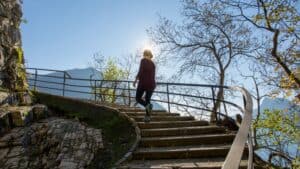
Do you have trouble with steps or kerbs? Do you sometimes feel unsteady coming down the stairs? Would you like to feel stronger, steadier or more confident on any steps or stairs (even when you’re out and about)?
If you’ve answered yes to one or more of these, don’t worry, you’re not alone. Keep reading, though, as you can take steps to feel safer and be more confident in these situations.
I’ve worked with hundreds of people to help them improve their balance, feel stronger and more confident coming down steps and stairs. I’ve watched them improve, I’ve seen the difference this has made to their lives, and I’d love to help you too.
So, when and where do we have the most difficulty with steps and stairs?
“I Don’t Have Any Trouble at Home”
Many people I work with have no problem at all with steps and stairs at home. Why is that?
To begin, we almost always have suitable handrails on stairs at home, which is a great help. Just as importantly, it’s a familiar setting. Even if there is a step or two without a rail, we’ve found coping strategies and feel confident in our environment.
We’re usually calmer at home too. There’s not so much external distraction or noise and, as long as we’re not rushing, we take our time and focus on the job at hand.
“It’s a Different Story When I’m Out and About”
The places where people tell me they struggle include public places, such as museums, galleries and restaurants. These can be especially challenging where there are no handrails on the steps.
Safely getting off buses and trains and out of taxis can also be a challenge. Single steps and kerbs can be tricky too. It’s only one step down, but without anything to hold onto, it can be nerve-wracking.
And, in gardens and parks, we often find a few steps down with no handrail and no wall to lean against.
Good Light Matters
If you’re indoors and it’s poorly lit or outside in the evening when it’s getting dark, steps and stairs can be much more difficult.
Low light levels make it much harder for us to safely navigate steps and obstacles, especially if we have trouble with our vision (e.g. cataracts, glaucoma or age-related macular degeneration).
Distractions Lead to Difficulties
These places are often busy too, with lots of people around, noises and other distractions. We may be stressed or preoccupied, perhaps worrying about where we need to go next or rushing for another train.
These distractions and concerns preoccupy our brains, leaving less brain capacity to pay attention to how we’re stepping off the bus or going down the stairs.
When Else Do We Find Stairs Harder Than Usual?
Everything is more problematic when we’re tired, including steps and stairs (even ones that we’re OK with at other times of day). So we need to take more care.
Also, when we’re carrying shopping bags or other items, they feel much more demanding.
Many of the women I work with are looking after grandchildren (whether on an occasional or regular basis). If they’re very young and need to be carried up and down the stairs, this requires lots of concentration and good stair-climbing ability.
What Do I Want for You?
I don’t want you feeling anxious about steps or stairs. They are everywhere, and the anxiety will affect your everyday life more than you realise.
I certainly don’t want you avoiding places with stairs. When you do this, you end up restricting the places you go, the things you can do and the people you can see.
I want you to be able to go out anywhere you want and feel confident you can deal with any steps or stairs you come across.
I also want you to avoid trips or falls on the stairs. The consequences of these can be even more devastating than falls on flat ground.
Our Strong and Steady on the Stairs Exercise Videos
I’ve seen many people become stronger and more confident through performing regular exercises. Tailored strength and balance exercises can help you improve your ability to navigate steps and stairs safely.
That’s why we developed the Strong and Steady on the Stair video series for our members.
The exercises in these videos are selected to improve your ability to navigate steps and stairs safely.
They will help you to have better mobility and stability in your ankles, knees and hips. You’ll strengthen the muscles you need for the stairs and feel more confident, especially going down the stairs.
Try This One Now (Yes, Right Now!)
Here’s one of the exercises from our Strong & Steady on the Stairs video series.
<iframe src=”https://player.vimeo.com/video/499973807″ width=”640″ height=”360″ frameborder=”0″ allow=”autoplay; fullscreen; picture-in-picture” allowfullscreen></iframe>
You’ll find the full Strong & Steady on the Stairs routines in the Vida Wellness Studio. It’s an online exercise studio – a membership site for people who want to improve their balance and posture, feel stronger and move more easily.
Members benefit from a library of clear, easy-to-follow exercise videos, along with advice, support and encouragement.
You can now get a 14-day free trial of the Vida Wellness Studio. You get a chance to try out all the Strong & Steady on the Stairs videos, as well as all the other great content in the Studio. You can see if it works for you and ask us any questions you have too!
Are there certain places where you have trouble with the stairs? Have you noticed particular times of the day or situations where you feel less steady? Would you like to feel stronger and more confident on the stairs?





